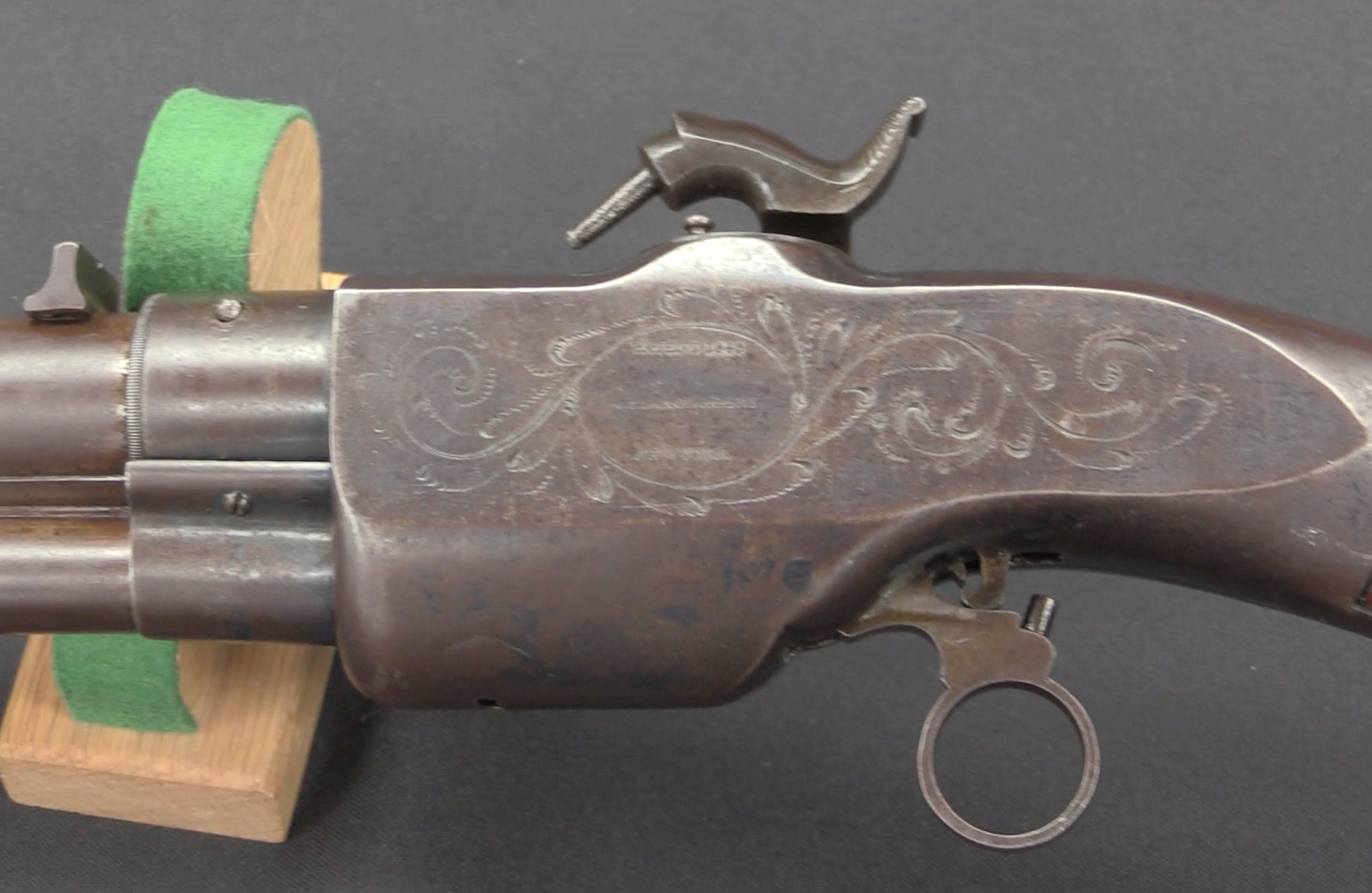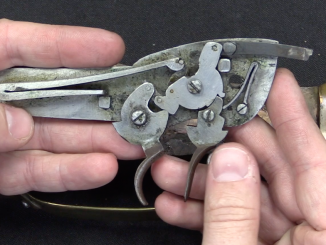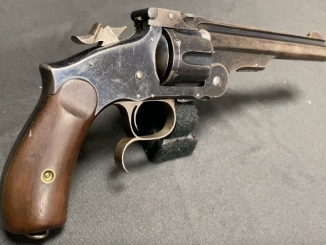The Spencer repeating rifle was a major leap forward in infantry firepower, and more than one hundred thousand of them were purchased by the US military during the Civil War. The Spencer offered a 7-round magazine of rimfire .56 caliber cartridges in an era when the single-shot muzzleloading rifle was still predominant. This particular Spencer is a long rifle which was one of roughly 1100 rebuilt from damaged carbines in 1871 at Springfield Arsenal.
Related Articles

Lever Action Rifles
RIA: 2nd Model Smith-Jennings Rifle

Gunsmithing


beautiful gun and i dont mean the condition although that is gorgeous as well, i mean the spencer rifle was a very clean line gun and just plain sexy (three band rifle especially)
Ingenious design to see and great video going into detail. Thanks!
My calculator says that the Spencer .56 round’s ballistics (360 gr @ 1200) add up to about 1,150 FPE at the muzzle, which is indeed about the ME of the .58 rifle musket.
The Henry lever-action fired a 200-grain at 1125 for 568 FPE, according to Barnes. This gives it about half the ME of the Spencer or the rifle-musket.
The difference is, as Ian stated, that the repeaters had a huge firepower advantage. Their effective range was about 300 meters, making them superior weapons for skirmish-type engagements.
They introduced the concept of rapid-fire, short to medium-range firepower concentration to warfare. In a very real sense, the Spencer, the Henry, and the Winchesters that followed them, were the “assault rifles” of the 19th century.
As for Christopher Spencer, don’t feel too bad for him. Unlike Christian Sharps who died in 1874, Spencer went on for a good long time. After the Spencer rifle went out of production, he designed and marketed one of the first tube-magazine, pump-action repeating shotguns, the Spencer Model 1890, built by the Bannerman company. They were quite popular as police and prison guard force guns well into the early 20th century; I saw one with Ohio Corrections Department stamps at my local stocking dealer a few years ago.
After the turn of the (last) century, Spencer more or less left the arms trade. He became interested in aviation, and learned to fly from the Wright Brothers(!) He was a financial backer of both them and Glenn Curtiss.
As to how he managed this, in 1904 he took over a small company named Tabulating Machines, Inc. that had been started by some of Herman Hollerith’s proteges’, and made a going concern of it. (They were good at designing machines to handle punch cards, not so good at business.)
A few years later, he changed the name to Business Machines, Inc., when they began branching out into other areas of business equipment, including the then-new electric typewriters. He ran the business until his death. About the same time, its name was changed again, to International Business Machines, Incorporated.
Yes, Christopher Spencer, of repeating rifle fame, was the founder of IBM.
His influence on American industry and world affairs in the early 20th Century, and stretching down to the present day, was as profound as it is generally unknown.
cheers
eon
Very interesting stuff Eon.
As I can relate to both, firearms and flying machines I see Mr. Spencer and a protagonist in wider sense. I knew about his former achievement, but did nor know about involvement with Wright Brothers. Good to have you here!
He also invented a automatic screw machine that was patented in 1873(U.S. patent #143,306). He started Hartford Machine Screw Company. They made millions of screws and bolts. This is what gave him the money to invest in other things.
FWIW, he didn’t patent the automatic turret on it or he’d have gained a lock on the market. Also, he started several other companies. He would only be directly involved for a few years and then turn over to others to handle the daily business. He appears to have known were his talents lay and followed them. Most people who are creative don’t like ‘the same crap-different day’ routine. He was wise enough to know that there are people who do ok with that routine.
Very good and true reminder. Creative people need to move ahead to something new; not to get stuck with ‘daily routines’ as you say.
“He became interested in aviation, and learned to fly from the Wright Brothers(!)”
This remind me of Hiram Maxim (of machine-gun fame). He also in later part of his life was engaged in aviation and also invent “Captive Flying Machines” which can be found in fairgrounds to our times. For images see article here: http://en.wikipedia.org/wiki/Hiram_Maxim#Flying_machines
Not a reply – a question motivated by pursuit of knowledge for its own sake.
I understand that the meaning of various terms for individual weapons may have (and did) change over history.
So for instance, “carbine” supposedly owes its name to the name of its first users, the cavalry troopers “carabin”/or “carab” – about whom I could not find any more aditional information. It was a weapon designed for cavalry (from firing in a mounted position, that is) – and from the start it was rifled. Finally it came to mean a shorter version of the infantry rifle (Mauser 1898 K), and ultimately a type of weapon developed independently of its infantry predecessor (such as M-1 Winchester of the WWII).
Rifle finally came to mean the full-sized infantry individual weapon. But it owes its English name (rifle) as well as its German equivalent (Gewehr) to the fact that its barrel was grooved.
Hence my question – with no malice aforethought – what is “rifle musket”?
I understood (correct me if I’m wrong) that “musket” was the weapon with the smooth bore. Granted, that for instance Italians have the word “moschetto” for Sumbachine guns (which, I presume) are grooved.
Regards, Andrzej
Outstanding video, Ian. Can’t get enough of these videos. Keep them coming!
I believe it was this rifle that the Rebels complained “Yankees can load once, and shoot all week!”
I didn’t realize that Spencer was such a prolific inventor/businessman. It’s nice to know that some of these designers prospered well into their old age, as many others seem to just disappear into obscurity, at least in terms of general history. My Spencer rifle and carbine are both very special to me, not only as fine, historical firearms, but because of how I acquired them. The carbine was passed down to me by my grandfather, and the rifle was a 15th birthday present from my “cool” uncle. Unfortunately, I have never been able to find ammo for them. Uberti makes a repro chambered for .45 LC which has been tempting me just so I could have one to shoot. In terms of Civil War era firepower, the soldier armed with one would definitely have an edge. IIRC Lincoln personally tested the first one on the White House lawn.
Spencers also are about my favorite rifles of that era. The era of 1850-1890’s is very interesting time for gun design. So many different designs that were made and sold. At the end of the 1890’s it seems that every design of manual repeater was done and after that it is just changes in manufacturing tech. Then is was on to perfecting the self-loaders.
The transition from black powder to smokeless would be an amazing study in itself. Gunsmiths weren’t chemists, and visa-versa.
I agree wholeheartedly; this was time of gun revolution results of which we are reaping till this day. Course was set in rather tumultuous circumstances; at the end rightly or wrongly it gave us what we have. I have huge respect for industrial thinkers of that period.
Arthur Savage was like this as well – from gold prospecting in Australia to cattle ranching to arms development including the box magazine and striker fire system(non-exposed hammer) to torpedo design to automobile radial tyre development!
Very nice video Eon. It is interesting in that the rifle has what appears to be a ram-rod. My father-in-law, an IWO survivor did MP work in Japan after the surrender. Among the few war trophies he brought home is a Spencer rifle, three band, in overall very good condition. It has Japanese script engraved onto the receiver side. Japanese language academics tell me it reads; “Import 1880”. Have you ever seen or heard if these before? I have a bundle of photos if interested.
I currently have two Spencer 3 band rifles. One is a documented civil war veteran that belonged to a notorious US captain that captured Champ Ferguson (confederate outlaw) and Beat up Joseph Wheeler (literally) at the close of the war. My other spencer is a New Model (1868) rifle. Less than 1k made and shoots steel targets at 100yards like a dream.
the spencer never got the notoriety it deserved because in the 50s and 60s making all those goofy cowboy movies they used Winchesters. as the Winchester was easily adapted to blanks(centerfire) and nobody could make 52 cal RIM FIRE blanks for the spencers.
the spencer was by far more prolific in the civil war and for ten years after from the surplusing from the army .
it is just in the last ten years your seeing it come into movies such as 3;10 to yuma ,unforgiven although it did make an appearance in the 80s in a great newzealand movie called UTU about the Native revolt there.
Having been a gun-nerd kid and history nut I was always fascinated by Civil War cartridge carbines, and aside from the Ballard the Spencer was always my favorite. Through a hometown collector I got to handle both a Henry and a Spencer and fire one round through a Spencer. It always struck me as a much more solid action than the obviously fragile Henry, and was more powerful by far. Always wondered if the decline of the Spenc and the rise of the House of Winchester was much more marketing than merit, sort of like the way we drive Fords instead of Stanleys.
Well, if you compare the Winchester 1966 model to a Spencer, the former has multiple practical advantages: it is easier and faster to reload, faster to shoot and in practice had a higher capacity due to the pistol cartridges used. The use of pistol cartridges was also a convenience for many users, since it allowed to use the same cartridge for the revolver. The Spencer was also it’s own worst enemy, since after the ACW they were available as surplus, which of course hurt sales of new rifles.
and way more likly to break down which is a distinct disadvantage in battle
the worst scene in dances with wolves is when he shoots a buffalo dead with a henry ? it wouldn’t have worked at all i’m thinking it was not much more than 22lr
The post-ACW .44 Henry rimfire loading (28 grs. of black powder) launched a 200 grain bullet at about 1,100 fps for 537 ft-lbs of muzzle energy from the Henry rifle, which was without a doubt enough to kill a buffalo with an accurate enough shot. 537 ft-lbs is more than twice the energy of even the hottest modern “hyper-velocity” .22 lr loadings. Modern .45 LC loadings generate about the same energy from a rifle length barrel. The main disadvantage of the .44 Henry was the quite poor ballistic coefficient of the bullet, which limited the effective range to about 200 yards (of course depending on the shooter; some sources say only 100 yards for an average shooter).
Nice to get a look at the magazine. But did the loader have to hold down each cartridge so the spring didn’t spew them all over the place?
A supposed manual I just found suggests dropping the rounds down the buttstock whole and pushing the tube in after them. Which still sounds like quite a trick with all those rims wanting to wobble around.